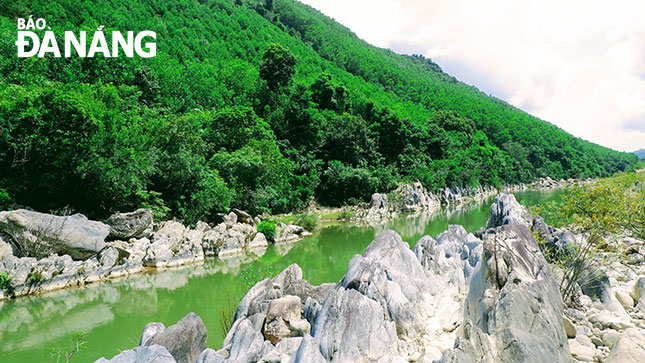Boosting ecotourism development in Hoa Vang
As the only rural district of Da Nang, Hoa Vang is generously bestowed with a diversified ecological environment, and this is the tremendous privilege for it to develop its community-based eco-tourism services.
 |
| The natural charm of the Vung Bot stream centrally located in the Ta Lang- Gian Bi area |
In addition to such tourist-packed sites as Sun World Ba Na Hills, the Hoa Phu Thanh tourist area, and the Nui Than Tai Hot Spring Park, there are other inviting venues showing off their great tourism development potential.
Notable amongst them are the community-based eco-tourism in the Ta Lang and Gian Bi villages in the district’s Hoa Bac Commune, and the Tuy Loan organic vegetable growing area in Hoa Phong Commune. However, this district is still facing some difficulties in fully tapping its eco-tourism development potential.
Fully aware of the district’s community-based eco-tourism development potential, Bui Hoai Vu, a 28- year-old Co Tu ethnic man, has been actively engaged in cooperating with local travel agencies in organising tours to the Ta Lang and Gian Bi villages.
These villages boast their pristine natural landscape such as wide and shallow streams. In addition, they feature many special characteristics which are imbued with the Co Tu ethnic minority people’s own identity, including cuisine, traditional crafts, Goul houses, gong arts, and the ‘tung tung da da’ dance.
The average tour price is 700,000 VND per person, covering sightseeing, dining, resting services. However, the price can be flexible, depending on the number of visitors, the length of the tour, and the extra needs of tour bookers.
More recently, Vu and some other Co Tu youths attended a training course on guiding skills, under the ongoing project for building a community-based tourism model associated with the preservation of the Co Tu culture in the Ta Lang and Gian Bi villages by 2020.
Mr Do Thanh Tan, the Head of the Culture and Information Department of the Hoa Vang District, however, pointed out some shortcomings in promoting the development of the community-based tourism.
In particular, there is a severe shortage of accommodations, souvenir shops, and human resources involved in this service. Also, infrastructure system for the development of eco-tourism has yet to be improved.
Meanwhile, over the past 2 years, the Tuy Loan organic vegetable growing area in Da Nang’s Hoa Vang District has welcomed a large number of pre-school, primary and junior high school pupils across the city who want to learn how to grow vegetables.
Farmers from the Tuy Loan Organic Vegetables Consumption and Production Service Cooperative have worked as professional tour guides of the pupils who are show keen interest in getting hands on farming experience.
During their visits to the Tuy Loan growing area, the children are introduced to different types of vegetables and fruits, and ways to keep their plants healthy. They also become actively involved in growing their own organic vegetables, weeding and catching caterpillars.
In the coming time, once sightseeing waterway routes from Tuy Loan communal village house to the Tich Thien Duong ancient house in Hoa Nhon Ward’s Thai Lai Village is open to vistors, the organic vegetable growing area is expected to become a must-visit site for domestic and foreign travellers during their stay in the city.
Hopefully, more investment will be poured into this location, hereby bringing more new community-based eco-tourism services to visitors.